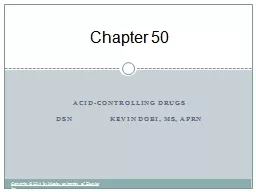PPT-Chapter 50
Author : phoebe-click | Published Date : 2015-10-18
AcidControlling Drugs DSN Kevin dobi MS Aprn Copyright 2014 by Mosby an imprint of Elsevier Inc The stomach secretes Hydrochloric acid HCl Bicarbonate Pepsinogen
Presentation Embed Code
Download Presentation
Download Presentation The PPT/PDF document "Chapter 50" is the property of its rightful owner. Permission is granted to download and print the materials on this website for personal, non-commercial use only, and to display it on your personal computer provided you do not modify the materials and that you retain all copyright notices contained in the materials. By downloading content from our website, you accept the terms of this agreement.
Chapter 50: Transcript
Download Rules Of Document
"Chapter 50"The content belongs to its owner. You may download and print it for personal use, without modification, and keep all copyright notices. By downloading, you agree to these terms.
Related Documents














